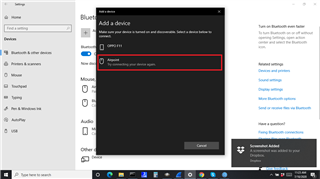Hi,
- we developed a 2D-3D mouse .It contains a 2D sensor and a 3D sensor and 4 touchpads for left click,right click and 3D motion enabling.
- The SDK we are using for developing our application is "nRF5_SDK_16.0.0_98a08e2" and examples "ble_app_hids_mouse" .
- We are using timer interrupt(app_timer) for reading and updating 2D ,3D sensor data and also to updating battery level to host pc and the gpio interrupt is using for updating the mouse clicks to host pc.
- In our code we are enabling all these interrupt after the bluetooth connection was established between our mouse and host pc .ie On "BLE_GAP_EVT_CONNECTED" event in main.c file under "ble_evt_handler" function .Please look the below screen shot for better under standings.

- Then we try to connect to our device to host pc the connection was not establishing in pc and its shows "Try connecting your device again " .please look the below screen shot.

- We find out the reason for this issue after some research and also with the support of nordic . ie,There are several other BLE events that are waiting to happen right after establishing a connection (BLE_GAP_EVT_CONNECTED event), as Service discovery, MTU update, data length update, PHY update, etc. if we are running so many things directly from inside the handling of the BLE_GAP_EVT_CONNECTED event we risk delaying and blocking other pending BLE softdevice events, and as a consequence perhaps even drop the connection if things take too much time.
- So our solution to counter this issue was instead of enabling all the interrupt inside the BLE_GAP_EVT_CONNECTED event we just enabled a single shot timer with delay 1 sec here and inside this timer handler we enabled all these interrupt.
- After this change in code we continuously tested our device on several PC .The result was uneven in different PC.ie, In some PC connectivity issue is showing and in some PC Its not showing .
- For detailed analysis we take the sniffer traces of both PC which showing the connectivity issue and also the PC which not showing connectivity issue . Sniffer traces are attaching below.
PC_WITH_CONNECTION_ISSUE.pcapng
PC_WITHOUT_CONNECTION_ISSUE.pcapng
- After the analysis of sniffer trace of both pc we comes to a conclusion. The PC with connection issue is taking more time to complete the BLE softdevice events(Service discovery, MTU update, data length update, PHY update, etc).The PC without connection issue is taking less time to complete the BLE softdevice events(Service discovery, MTU update, data length update, PHY update, etc).
- Why this time difference is showing in different PC ?
- when we increased the single shot timer interval to 5 sec connection issue was not showing in any PC but we can't allow this much delay to enable the all features in our device after the BLE connection was established.
- Please help us to find a proper solution to counter this issue.
NOTE :- Refer the sniffer trace from "Number" 4200 in PC_WITH_CONNECTION_ISSUE. Refer the sniffer trace from "Number" 8656 in PC_WITHOUT_CONNECTION_ISSUE.
